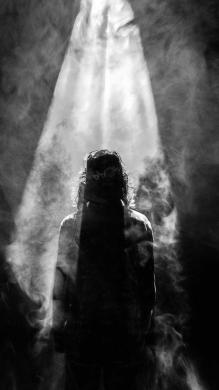Ever wondered about those supernatural elements in the Easter story? Mentions of ghosts and a body being raised back to life?
In this piece, we explore how the supernatural elements of the Easter story fit into this ancient narrative – and what they might mean for those who believe them today ...
Ever experienced something that you just can’t explain – something that goes against reason?
We explore *those* moments in the Easter story – you know, the ones that seem like they shouldn’t be happening.
You joining?
 Angels, angel numbers, guardian angels … where do you sit?
Angels, angel numbers, guardian angels … where do you sit?
And what do you think the Bible might have to say about angels? Well, maybe you think a fair bit, actually. You might remember that angelic figure in your primary school nativity, but you couldn’t say exactly what the ancient writers would have believed or what biblical authors might have to say about angels.
Well, that's what we’re exploring here by zoning in on the Easter story, which features references to angels, ghosts and rumours of a dead man coming back to life across four personal accounts of this miraculous event.
Wondering where angels pop up in the Easter narrative, and what the Bible writers might have to say about these celestial beings?
Let’s set the scene. When we first get reference to angels in the Easter story, Jesus has been killed and buried in a tomb, covered over by a large stone. Two days after his burial, two women – both called Mary – go to visit his tomb. And that’s when things get interesting.
This narrative is covered in the first four books of the New Testament, and the authors communicate it in slightly different ways. According to Matthew’s report, ‘there was a violent earthquake; an angel of the Lord came down from heaven, rolled the stone away, and sat on it.’ (Matthew 28.2, GNB).
Not your typical Sunday morning ...
But how does this presentation of angels line up with what we picture when we think about angels – even if we don’t believe in them?
The author offers a brief description of what this angel looks like: his ‘appearance was like lightning, and his clothes were white as snow.’ (Matthew 28.4).
Perhaps this matches the image in your head. But what might surprise you is that we don’t get any references to wings or halos here. Within Christian art, the image of angels as winged beings wasn’t popularised until around the fourth century.
In fact, the writer doesn’t give any clear indicators of what this angel looks like or how he differs from humans – instead, it's the angel’s supernatural arrival that sets it apart.
Put simply, the main thing we learn about this angel is that he’s a messenger. In fact, the English word ‘angel’ is derived from the Greek word ‘angelos’, which literally means messenger.
Part of a much larger narrative about a higher being – understood as God – and his relationship with humanity, this dazzling figure has a message to share with these women: a message that continues to inspire the personal beliefs of more than two billion people around the world, all these years later.
So, what’s the angel saying?
Given the fact that the women are startled by the angel’s sudden appearance (wouldn’t you be?), the angel starts with a comforting message to not be afraid (Matthew 28.5). (If you’re familiar with the Christmas story about Jesus’ birth, then you might remember the angels who appeared to the shepherds said something similar.)
Then, the angel has a pretty surprising message: ‘I know you are looking for Jesus, who was crucified. He is not here; he has been raised, just as he said.’ (Matthew 28.4–5).
He finishes with an instruction and a message of hope. First, to go and tell Jesus’ close friends and followers what’s happened, and tell them to go to a place called Galilee where they’ll meet Jesus for themselves.
In the Easter story, we get a supernatural story about an angelic being with a message to share. But what else is going on here? What other supernatural elements jump out in the Easter story?
 What do you think about ghosts? Maybe you believe in them; maybe you’ve experienced something strange that gives you reason to. Or perhaps you think it's nonsense – sure, you have a story about being ghosted, but nothing supernatural.
What do you think about ghosts? Maybe you believe in them; maybe you’ve experienced something strange that gives you reason to. Or perhaps you think it's nonsense – sure, you have a story about being ghosted, but nothing supernatural.
Or maybe you’re somewhere in the middle; you’re not sure what to think about ghosts, but you acknowledge that there are some things that can’t be explained, things we struggle to get our heads around.
But did you expect the Bible to mention ghosts? Let's find out what the Easter story has to say ...
Across the four Gospel accounts of Jesus’ death, we only get one reference to ghosts, which is found in the book of Luke, an author who was writing to people of all different beliefs and spiritual backgrounds.
According to him, after the women visit Jesus’ tomb and found it empty, they tell the disciples what happened ... and they don’t believe them. A dead man coming back to life – not something you hear every day, is it?
But then, just as the angel said, Jesus visits them. They don’t recognise him at first and then they do. The Gospel describes their reaction like this: ‘They were terrified, thinking that they were seeing a ghost.’ (Luke 24.37) ... Understandable!
Jesus’ close friends and followers initially think Jesus – who they saw suffer a painful death days before – had to be dead. But does that mean this is an ancient example of a ghostly encounter?
Well, not exactly. The Bible writer isn’t trying to create a ghost story here. Actually, he’s pretty much doing the opposite. Their story isn’t about death, ghosts and ghouls, although it’s still about something supernatural. It's actually about life and restoration – something that Jesus tries to clear up when he says this:
‘Look at my hands and my feet, and see that it is I myself. Feel me, and you will know, for a ghost doesn't have flesh and bones, as you can see I have.’ (Luke 24.39).
So, does this mean that the disciples believed in the paranormal – and what might that say about Jesus’ identity? Admittedly, this isn’t the only time the disciples refer to ghosts. They also think Jesus is a ghost in another Gospel story, about Jesus’ miraculous ability to walk on water.
Taken from the Greek ‘phantasma’, Luke’s use of the word ‘ghost’ can refer to an apparition, spirit or phantom, which may suggest that the disciples had a belief in evil spirits. Or they at least used this language to try and understand and communicate something miraculous – a dead man coming back to life.
But, if we were to take the view that Jesus isn’t a ghost – as he says – what does this mean?
 The two things we’ve covered up until this point – angels and ghosts – aren’t really the main focus of the Easter narrative.
The two things we’ve covered up until this point – angels and ghosts – aren’t really the main focus of the Easter narrative.
In fact, we’ve sort of been tiptoeing around the elephant in the room: the suggestion that a dead body was raised back to life, and the repercussions this has on the Easter story, the Bible’s overarching message, and what people believe and how they live their lives as a result – even 2,000 years after these events are said to have taken place.
In short, it’s making a claim about his identity, about his relationship with God, and about his relationship with humanity.
Although the Bible is made up of lots of smaller books, it has an overarching narrative. Ultimately, it tells the story of a creator God, who creates humans here on earth, offering them a relationship with each other, the planet in their care, and the creator.
Things turn messy, and humanity messes up – a pattern that keeps repeating. But, through it all, there are signs of hope dotted throughout ancient writings that suggest it won’t always be this way.
In the New Testament, this hope is fulfilled through the life, death and miraculous rising of Jesus. More than just a spiritual thinker, the writers believed Jesus is God in human form, sent to bridge the gap between us and creation.
In fact, the whole of the New Testament is a gathering of writings in different genres, written in different times and places, describing how they came to think this, and what it might mean for their lives – and the planet – going forward.
Jesus' life, death and, for those who believe it, resurrection offers a message of hope, which – for Christians – acts as a high point in the Bible’s overarching narrative.
From the very start, this ancient collection of writings makes a statement about how human beings were made on purpose, with purpose.
According to these authors, humanity was made by a creator God who wants to be in relationship with us – an idea that is cemented when this higher being comes to live a life among us. And ultimately, it offers a message that says, if God can raise a dead body to life again, is anything really broken beyond repair?

More can be fixed than you think
Work, deadlines, the dating scene, the planet: Could an ancient story have something to say about the things that matter to you today?

What does the moon have to do with Easter?
Ever wondered why the date of Easter moves each year? Explore how the moon plays a part – and why so many religious festivals around the life of Jesus seem to be linked to the night sky.

Easter Reborn: From the Rites of Spring to the Rising of Jesus
Chocolate eggs. The Easter Bunny. Does Easter have ancient pagan roots? How did it become associated with Jesus? Discover the true origins of Easter.
If you’re curious about the Bible but wouldn’t consider yourself particularly religious, you’re in the right place. Sign up to hear about future content designed for people like you.
 Loading
Loading